Why does my GFI keep tripping? How do I fix this? Do GFCI outlets go bad? These questions and more will be answered in this GFCI outlet guide.
Table of Contents –(GFCI Guide)
What is a GFCI?
The ground-fault circuit interrupter (GFCI) is a fast-acting circuit breaker designed to shut off electric power in the event of a ground fault. GFCI outlets prevent a person from getting electrocuted when water comes in contact with an outlet. GFCI outlets are required anywhere outlets may contact water. For example, you’ll typically find GFCI outlets in bathrooms, basements, kitchens, laundry rooms, and garages.
According to Home Depot: “GFCI protection is required for 125-volt to 250-volt receptacles supplied by single-phase branch circuits rated 150 volts or less to the ground.”
Have you ever used the hairdryer near the sink with water in it and thought to yourself, “Would I get an electrical shock if I dropped the hairdryer in the sink?” And then you look over to the wall and notice a weird-looking outlet with a reset button on it. That’s a GFCI outlet.
Picture of GFCI Outlet
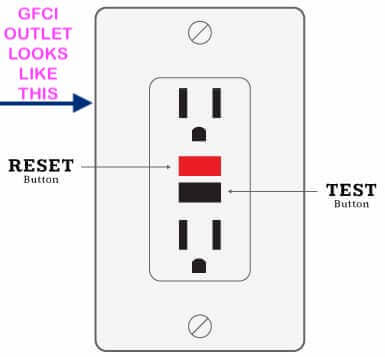
5 Reasons Your Ground-Fault Circuit Interrupter (GFCI) Outlets Keeps Tripping
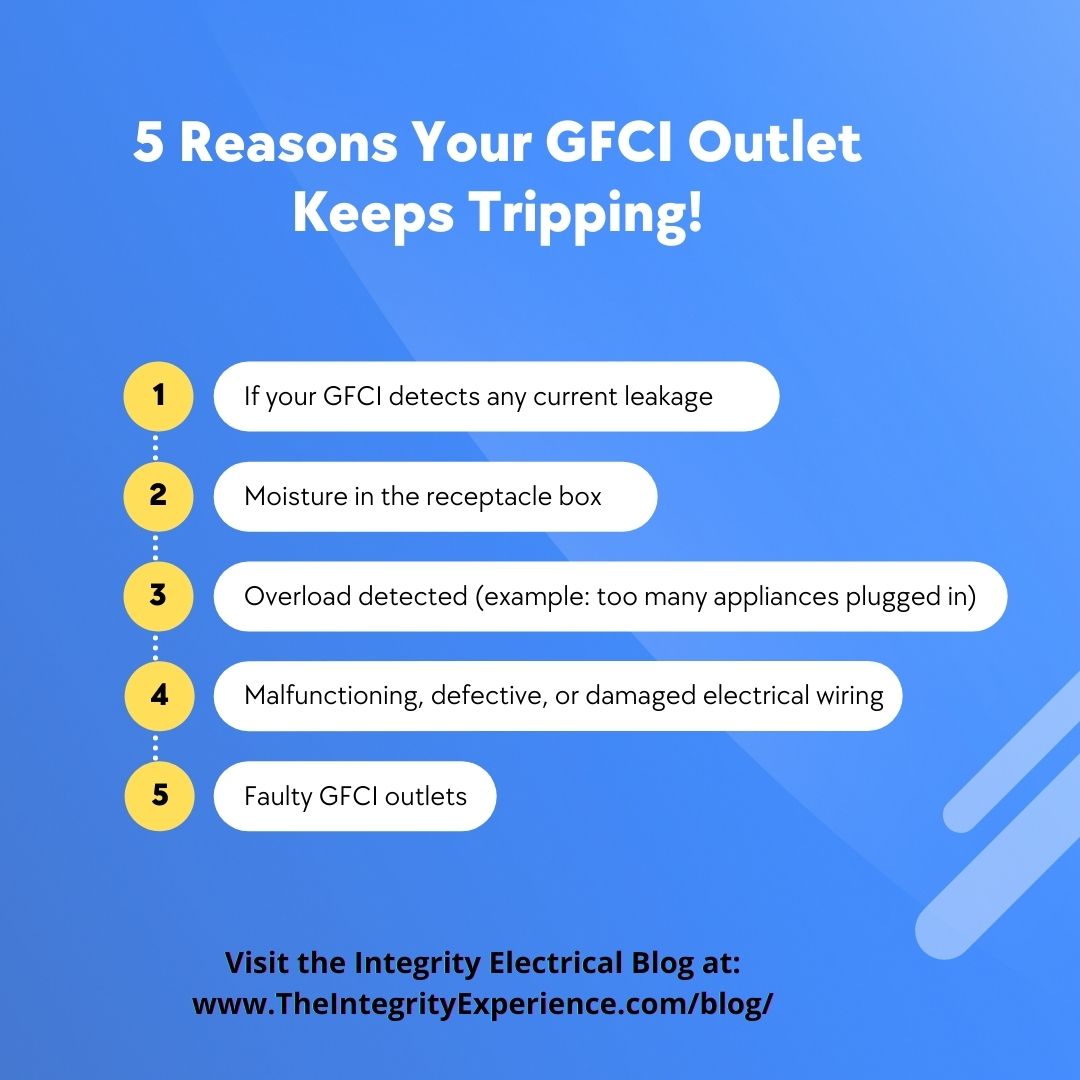
- If your GFCI detects any current leakage, it trips automatically as a safety precaution. Technically speaking, this current leakage can be caused by a hot wire touching the ground somewhere on the electrical line.
- Moisture in the receptacle box is another common cause of a GFCI outlet tripping.
- When a GFCI outlet detects an overload, it trips. Overloads can occur from simply plugging too many devices in at once or having too much electrical current running at a given time on a particular circuit.
- Malfunctioning, defective, or damaged electrical wiring can result in a tripped GFCI outlet. As Integrity Electrical’s CEO, Joe O’Connell, says below, “GFCI outlets typically last 10-15 years. In my experience, if your outlets are that old, you should have them tested and inspected.”
- Faulty GFCI outlets can be due to age or a defective product. Unfortunately, bad GFCI outlets exist. Luckily they can easily be replaced using the standard 2-Year Limited Warranty for electrical outlets & receptacles.
GFCI Outlets and Electrical Safety
Electrical safety is always a top priority when it comes to the way manufacturers build most electrical devices. Electrical safety mechanisms, such as a GFCI, act as insurance, protecting manufacturers from getting sued.
What the law says about GFCI Outlets: National Electric Code (NEC):
How do you fix a GFCI that keeps tripping?
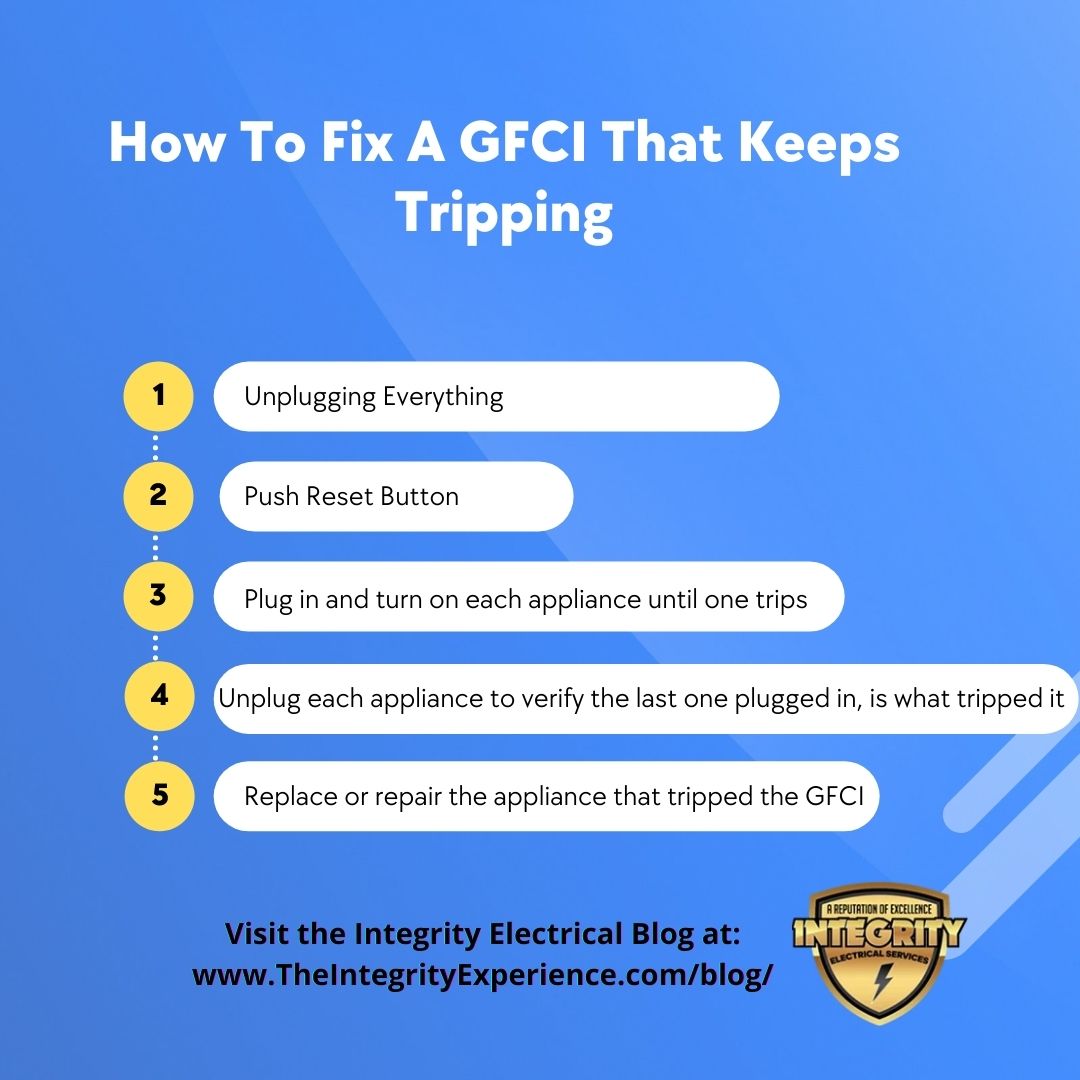
- Start by unplugging everything connected to that outlet’s circuit.
- Push the button that says “reset.”
- Troubleshoot the issue by plugging in and turning on each appliance until one trips.
- Unplug each appliance plugged in before the GFCI tripped to verify the last appliance you plugged in is what tripped the GFCI. If so, that appliance likely has a ground fault.
- Replace the GFCI outlet if it’s bad. Repairing a GFCI outlet is another option that only a licensed electrician should attempt to do. And if it’s a problem related to an overload on the electrical circuit, you could fix the problem by plugging in fewer appliances.
How to Install a GFCI Outlet
To install a GFCI outlet, you’ll need:
(1) a voltage tester
(2) a Phillips head screwdriver
(3) a GFCI receptacle
(4) electrical tape
(5) a wire stripper
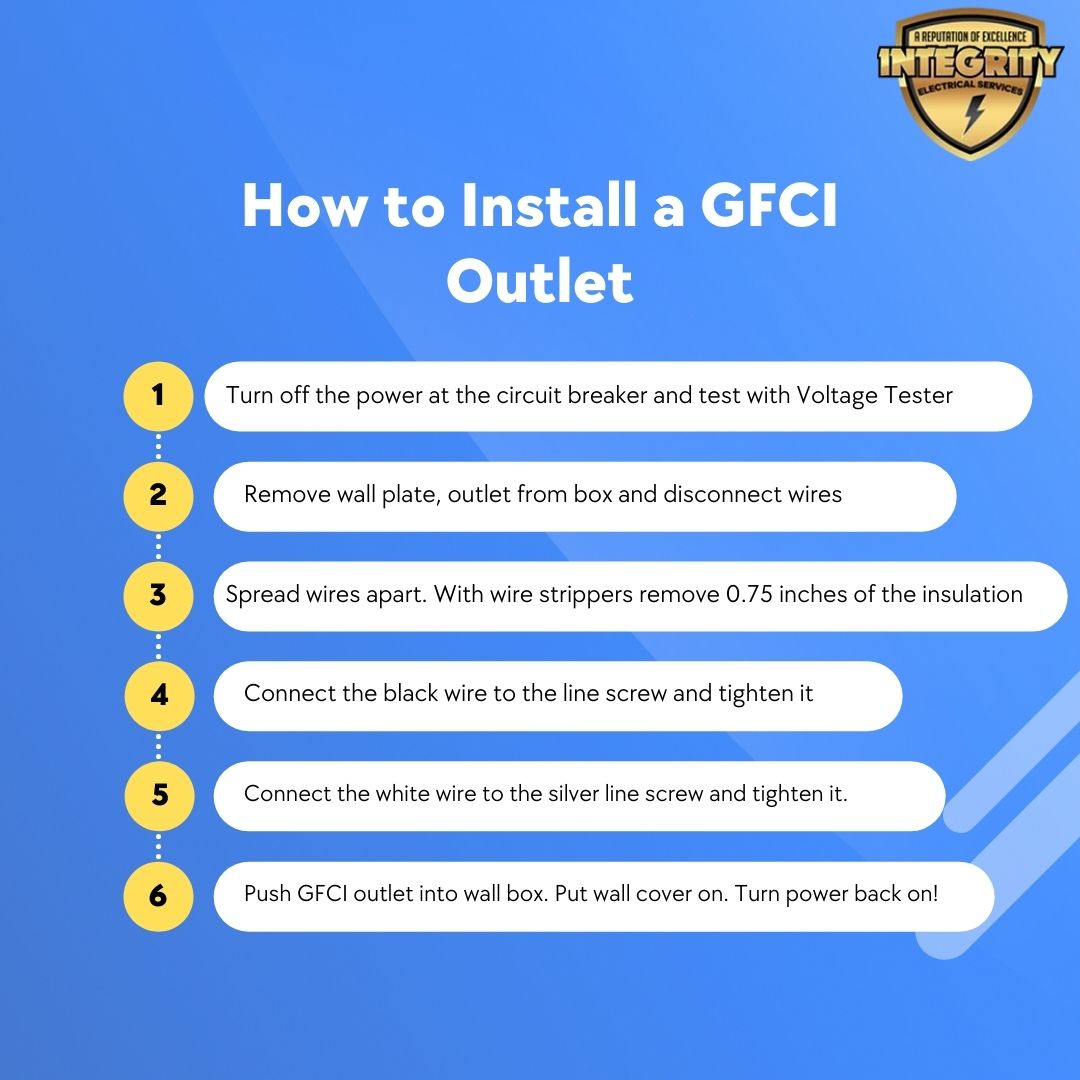
- Turn off the power at the circuit breaker inside your panel box.
- Use a voltage tester to confirm the power is off.
- Remove the existing wall plate by unscrewing the two screws holding the outlet in place.
- Remove the outlet from the box and disconnect the wires.
- Spread wires apart (there should be three wires) and use the wire strippers to remove three-quarters of an inch of the insulation (note: green = ground, white = neutral, and black = hot). Make sure to recognize which wire is coming from the main panel.
- Go back into your panel box and turn the power on.
- Touch each black and white wire using the voltage tester to ensure the tester lights up. Then turn the power back off. Now you’re ready to go!
- GFCI outlets have four terminals; two labeled “line” and two marked “load.”
- Connect the black (hot) wire to the brass screw and tighten it.
- Connect the white (neutral) wire to the silver line screw (terminal) and tighten it.
- Push the GFCI outlet into the wall box. Replace the mounting screws and put the cover back on.
- Turn the power back on and plug in your appliance to test it. And you’re done!
Source: Watch the Full Instructional Video at Home Depot Video Instructions How to Install GFCI Outlet
My GFCI outlet is not working?
According to Joe O’Connell, the owner of Integrity Electrical Services;
“GFCI outlets typically last 10-15 years. In my experience, if your outlets are that old, you should have them tested and inspected. Exposure to excessive heat, moisture, water, or UV light can cause GFCI outlets to fail over time. ”
GFCI outlets are unique outlets that have built-in circuit breaker protection. Therefore, if a short or overload occurs, not only the GFCI outlet goes bad, but all outlets around it could stop working.
Best case scenario: hit that reset button on the GFCI outlet, and it magically starts working again. But you’re not always going to be so lucky.
If your GFCI reset button doesn’t fix the problem, you may want to check for a tripped circuit breaker inside your electrical panel.
Have a question or need an electrician? Call one of our local and licensed electricians at Integrity Electrical Services at (978) 753-8350.
How to Check for a Tripped Circuit Breaker?
Open up your electrical panel box and check if one of the breakers is turned off or out of line with the rest.
If you find a breaker that’s turned off, turn it back on, and then off, and then on again. Make sure you hear that click each time you turn it on and off.
If the breaker turns on but then continues to trip, that’s not a good sign, and you could have a short in the line.
Detailed Troubleshooting for Dead GFCI outlets:
- Check other outlets to make sure it’s only the one that’s not working. Use a voltage tester if you have one.
- As mentioned above, head down to your circuit breaker box and check for any tripped breakers.
- If you find a tripped breaker, turn it on and off and then on again. If the breaker trips again, not staying on, you could have a severe problem.
- If you have a fuse box, check for any burned or blown fuses (note: blown fuses usually appear brown).
- Rest your GFCI outlet by using the test and reset button. First off, if the test button doesn’t pop back out after you press it, the GFCI outlet could be bad, or there could be no power to the GFCI.
- Make sure to push the reset button on all of your GFCI outlets, to verify all are working.
- Are you still getting no power? First, turn off your main breaker service inside your electrical panel box. Next, unscrew the GFCI outlet and look for loose wires and terminal screws. If you find a loose or burned wire, in this case, you may need to replace the outlet entirely. Don’t try replacing the outlet on your own; it’s not worth the headache and potentially looping together the wrong wires, resulting in a worse electrical problem.
Is your GFCI outlet continuing to trip?
If you’ve tried everything and your GFCI continues to trip, the underlying condition could be due to a current leak.
A current leak could be a sign of danger.
Please do not mess around in this case and play Mr. Electrician, trying to troubleshoot it on your own.
If you live in Massachusetts, one of our Wilmington-based electricians can help. Call (978) 753-8350 today. We service most cities and towns in Massachusetts (MA) and nearby Reading, Andover, and Woburn. Integrity Electrical Services was recently awarded #1 Rated Electrical Company in MA and is 5-star rated on Google. The company is also 5-star rated on HomeAdvisor with 99% approval ratings and A+ BBB.
Lastly, we’ll answer a few frequently asked questions about GFCI outlets.
Do GFCI Outlets Go Bad?
Yes, GFCI outlets go bad.
The average lifespan for a GFCI outlet is ten to fifteen years.
Therefore, if you have an older home, you’re more likely to experience GFCI outlets going bad.
Can a bad breaker cause a GFCI to trip?
No, but it won’t reset if you have any power.
Bob Johnson, a licensed electrician, stated, “Probably not. If the breaker is on the supply ‘LINE’ side of the GFCI, then no—keep looking for an additional problem on the ‘LOAD’ side of the GFCI. On the load side, I suppose a failed breaker could create a high resistance short to ground and trip the GFCI. But having a breaker on the load side would be unusual.”
Bottom line: If the breaker is bad, it’s not sending power to the outlet. That’s why you can’t reset it.
Sources:
Mister Sparky, “Do GFCI outlets go bad?”, Mistersparkykc.com
Bob Johnson, “Can a bad breaker cause a GFCI to trip?”, https://www.quora.com/
5 Common Types of GFCI Outlets
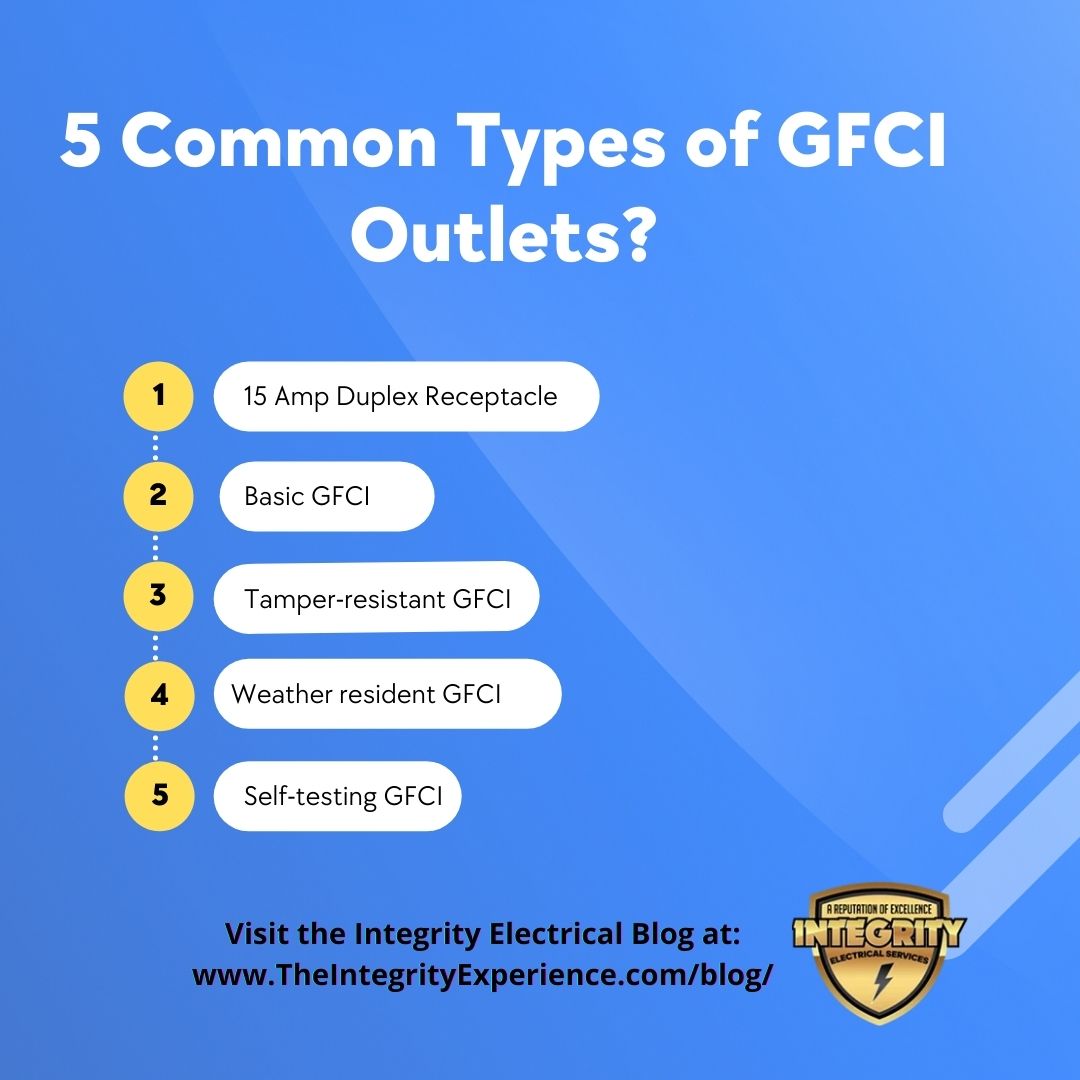
- (1) 15 Amp Duplex Receptacle (known as the standard electrical outlet, used in most homes in the United States)
- (2) Basic GFCI
- (3) Tamper-resistant GFCI
- (4) Weather resident GFCI (often used for outdoor areas, including porches, decks, and pool areas)
- (5) Self-testing GFCI
All of these GFCI outlets can be purchased from Home Depot or Lowes.
Source: Homeelectrical.com, What Are The Different Types Of GFCI Outlets?

